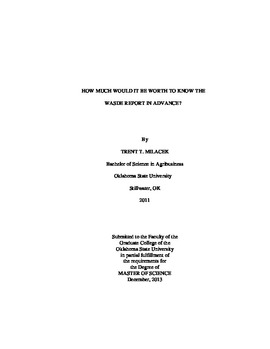| dc.contributor.advisor | Brorsen, B. Wade | |
| dc.contributor.author | Milacek, Trent Thomas | |
| dc.date.accessioned | 2015-06-17T20:07:04Z | |
| dc.date.available | 2015-06-17T20:07:04Z | |
| dc.date.issued | 2013-12-01 | |
| dc.identifier.uri | https://hdl.handle.net/11244/15011 | |
| dc.description.abstract | Past research has shown that prices move in response to WASDE reports, but have only looked at price movements immediately prior to and after a report. This research seeks to determine the profitability of trading based on knowing the next WASDE report at the time of the current report. This should help traders evaluate investments in efforts to predict the information contained within the report. The commodities used in the model are US corn, soybeans, and wheat. The variable position and rolling regression models are price forecasting models that use an ending stocks regression to forecast price at the next WASDE report release. For the variable position model, the intercept is calibrated so that the model predicts the current price without error; the slope is based on report data from no more than the last two years of data. The rolling regression model uses a specified amount of historical data from one to five years in its regression. Using the forecasted price, the position of the trading model's profit calculation can change daily based on where the closing price of the commodity is in relation to the price prediction. These two models are compared to determine the optimal amount of historical information to include in the price forecast. The trade and hold model is used to determine the profits of trading based on whether ending stocks will be up or down at the next WASDE report. Profits are averaged on a days until report, monthly, and yearly basis. The variable position model and rolling regression model show a steady return to trading over the report month. The trade and hold model shows an increase in profits on the report release day. Ending stocks and predicted yield account for a small yet very important part of market movements. Trading models that include more information are needed to produce accurate price forecasts. Trading close to the report, during the growing season, and trading historically important WASDE reports that contain finalized information are the keys to maximizing trading profitability. | |
| dc.format | application/pdf | |
| dc.language | en_US | |
| dc.publisher | Oklahoma State University | |
| dc.rights | Copyright is held by the author who has granted the Oklahoma State University Library the non-exclusive right to share this material in its institutional repository. Contact Digital Library Services at lib-dls@okstate.edu or 405-744-9161 for the permission policy on the use, reproduction or distribution of this material. | |
| dc.title | How Much Would It Be worth to Know the Wasde Report in Advance? | |
| dc.type | text | |
| dc.contributor.committeeMember | Jones, Rodney D. | |
| dc.contributor.committeeMember | Adam, Brian D. | |
| osu.filename | Milacek_okstate_0664M_13171.pdf | |
| osu.accesstype | Open Access | |
| dc.description.department | Agricultural Economics | |
| dc.type.genre | Thesis | |
| dc.subject.keywords | corn | |
| dc.subject.keywords | futures | |
| dc.subject.keywords | soybeans | |
| dc.subject.keywords | usda | |
| dc.subject.keywords | wasde | |
| dc.subject.keywords | wheat | |
